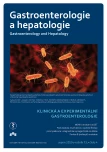Dysphagia as a symptom of an adverse effect of anticoagulant therapy
Authors:
Kolářová R.
Authors‘ workplace:
Endoskopické centrum, Oblastní nemocnice Náchod a. s.
Published in:
Gastroent Hepatol 2019; 73(4): 336-338
Category:
Clinical and Experimental Gastroenterology: Case Report
doi:
https://doi.org/10.14735/amgh2019336
Overview
This case report presents an unusual side effect of dabigatran that can lead to drug-related esophageal mucosal involvement, known as dabigatran-induced esophagitis, manifested by dysphagic problems and typical endoscopic findings, especially in predisposed patients. After discontinuation of dabigatran, clinical problems rapidly resolved and endoscopic findings normalized.
Doručeno/Submitted: 3. 6. 2019
Přijato/Accepted: 23. 7. 2019
MUDr. Renata Kolářová
Endoskopické centrum
Oblastní nemocnice Náchod a. s.
Purkyňova 446
547 01 Náchod
kolarova.renata@nemocnicenachod.cz
Konfl ikt zájmů: Autorka deklaruje, že text článku odpovídá etickým standardům, byla dodržena anonymita pacientů a prohlašuje, že v souvislosti s předmětem článku nemá
fi nanční, poradenské ani jiné komerční zájmy.
Publikační etika: Příspěvek nebyl dosud publikován ani není v současnosti zaslán do jiného časopisu pro posouzení. Autorka souhlasí s uveřejněním svého jména a e-mailového
kontaktu v publikovaném textu.
Dedikace: Článek není podpořen grantem ani nevznikl za podpory žádné společnosti.
Redakční rada potvrzuje, že rukopis práce splnil ICMJE kritéria pro publikace zasílané do biomedicínských časopisů.
Confl ict of Interest: The author declares that the article/manuscript complies with ethical standards, patient anonymity has been respected, and she states that she has no
fi nancial, advisory or other commercial interests in relation to the subject matter.
Publication Ethics: This article/manuscript has not been published or is currently being submitted for another review. The authors agree to publish their name and e-mail in
the published article/manuscript.
Dedication: The article/manuscript is not supported by a grant nor has it been created with the support of any company.
The Editorial Board declares that the manuscript met the ICMJE „uniform requirements“ for biomedical papers.
Keywords:
bleeding – esophagitis – dysphagia
Sources
1. Duda M, Hildebrand T. Jícen a kardie. In: Mařatka Z et al. Gastroenterologie. 1. vyd. Praha: Karolinum 1999 : 53–54.
2. Ootani A, Hayashi Y, Miyagi Y. Dabigatran-induced esophagitis. Clin Gastroenterol Hepatol 2014; 12 (7): e55–e56. doi: 10.1016/j.cgh.2013.09.010.
3. Matsuura H, Suto K, Yasuhara H et al. Longitudinal sloughing mucosal casts: dabigatran-induced oesophagitis. Eur Heart J 2018; 39 (36): 3400. doi: 10.1093/eurheartj/ehy538.
4. Singh S, Savage L, Klein M et al. Severe necrotic oesophageal and gastric ulceration associated with dabigatran. BMJ Case Rep 2013. bcr2013009139. doi: 10.1136/bcr-2013-009139.
5. Wood M, Shaw P. Pradaxa-induced esophageal ulcer. BMJ Case Rep 2015. bcr2015211371. doi: 10.1136/bcr-2015-211371.
6. Kajihara Y. Dabigatran-induced esophagitis. Cleve Clin J Med 2019; 86 (5): 303–304. doi: 10.3949/ccjm.86a.18117.
7. Kajihara Y. Exfoliative esophagitis. Eur J Intern Med 2018; 53: e1. doi: 10.1016/j.ejim.2017.12. 013.
8. European Medicine Agency. SPC Pradaxa. [online]. Dostupné na: https: //www.ema.europa.eu/en/documents/product-information/pradaxa-epar-product-information_cs.pdf.
9. Nyuzuki S, Yamakawa R, Kawauchi K et al. Clinical study of esophagitis induced by dabigatran. [online]. Available from: https: //cdn.ueg.eu/uegfolga-web/uegf-ep-mat088/P1039.pdf.
10. Toya Y, Nakamura S, Tomita K et al. Dabigatran-induced esophagitis: the prevalence and endoscopic characteristics. J Gastroenterol Hepatol 2016; 31 (3): 610–614. doi: 10.1111/jgh.13 024.
11. Katzka DA. Esophageal disorders caused by medications, trauma, and infection. In: Feldman M, Friedman LS, Brandt LJ (eds). Sleisenger and Fordtran’s gastrointestinal and liver disease. 9th ed. Philadelphia: Saunders/Elsevier 2010 : 735–737.
Labels
Paediatric gastroenterology Gastroenterology and hepatology SurgeryArticle was published in
Gastroenterology and Hepatology

2019 Issue 4
- Metamizole at a Glance and in Practice – Effective Non-Opioid Analgesic for All Ages
- Metamizole vs. Tramadol in Postoperative Analgesia
- Possibilities of Using Metamizole in the Treatment of Acute Primary Headaches
- Metamizole in the Treatment of Acute Postoperative Pain
- Spasmolytic Effect of Metamizole
Most read in this issue
- Insulinoma as a cause of severe hypoglycemia in a patient with neurological symptoms
- Part 4 – Mortality and life expectancy in IBD patients
- New oral anticoagulants and upper gastrointestinal bleeding
- Dysphagia as a symptom of an adverse effect of anticoagulant therapy
